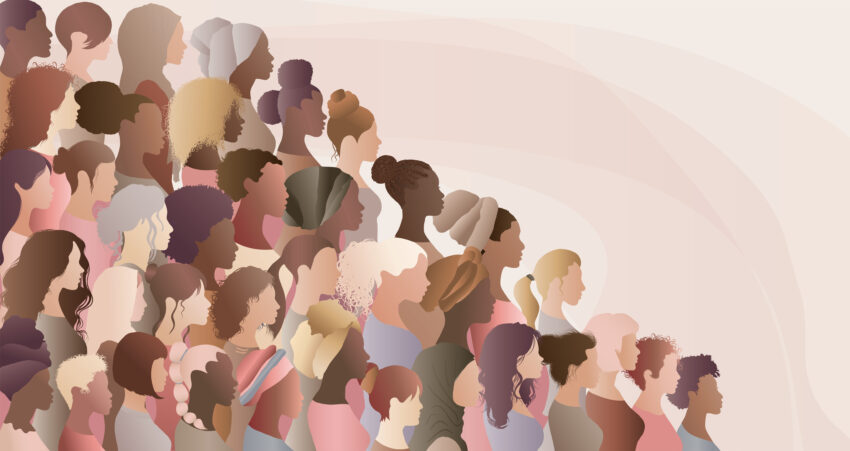
Share On Social!
As of 2023, there are 169 million women and 166 million men living in the US.
While men and women share many of the same health risks and concerns, women have their own unique challenges, such as reproductive cancers and maternal health, and are more prone to certain diseases and adverse health conditions.
Women, especially women from racial/ethnic and underserved populations, including Latinas, are exposed to barriers to healthcare resulting in worse health outcomes.
Let’s explore six disparities impacting women’s health in the US.
1. Cancer Screenings
Several cancers affect women more than men, or specifically impact women, such as cervical and ovarian cancers.
This makes cancer screening so important for women.

However, women, especially women of color, face a lot of barriers to receiving regular cancer screenings, stemming from the impact of social determents of health, such as socioeconomic status, access to healthcare, and access to transportation.
Take breast cancer, a cancer that is dominate among women, for example.
A study exploring the role social determinants of health (SDoH) plays in mammogram use in women ages 50 to 74, found that 65.7% of women who hadn’t received a mammogram over a two-year period faced three or more SDoH issues.
Those impacted by SDoH cited cost, lack of reliable transportation, lost or reduced hours of employment, and food insecurity as reasons for the lapse in mammogram screenings.
Mammograms have been shown to reduce the number of breast cancer deaths by 22%.
Breast cancer continues to disproportionately affect women of color, who face racism and discrimination as a barrier to life-saving cancer screenings, leading to higher rates of cancer-related deaths.
Lack of access to cancer screenings results in getting diagnosed at a later stage when treatment is more costly, and the outcome of treatment isn’t as favorable. Latinas especially struggle with late-stage diagnosis of breast cancer.
Explore cancer prevention and early detection resources.
2. Access to Affordable Healthcare
Cost is a driving factor for many when it comes to seeking medical care and treatment.
Women between ages 44 to 64 living in the US spend 24% more money on healthcare than men, according to an article published by Oliver Wyman Health.
In women younger than 44, healthcare spending is 84% higher than men, with childbirth bearing the brunt of the costs.
If women have more healthcare expenditures, why don’t they have more help to pay for it?
The burden of cost has a lot to do with the lack of insurance.
Low-income individuals and seniors can take advantage of state funded medical insurance through Medicaid, which insures many people of color, and Medicare.
However, women don’t make up a large portion of those receiving these benefits.
Women only account for 56% of Medicare Advantage enrollees and make up only 36% of Medicaid beneficiaries, according to Oliver Wyman Health.
Women without health insurance tend to delay medical care and treatment, forgo life-saving cancer screenings, and can have worse health outcomes and higher rates of death.
In response to the cost inequities in women’s healthcare, Oliver Wyman Health suggests the need for increasing access to the essential and diverse health needs of women, reporting more accurate health data, and identifying inequities in women’s healthcare.
3. Gender and Racial/Ethnic Bias
When visiting healthcare professionals, women can sometimes face gender bias, creating a barrier to equitable care.
Women disproportionately suffer from many chronic illnesses, diseases, and conditions such as heart disease, autoimmune disease, and irritable bowel syndrome (IBS).
In women’s reproductive health, women may suffer from ovarian cysts, endometriosis, and uterine fibroids.

Many of these conditions can be considered painful and difficult to manage.
In a profession dominated by men, women have a difficult time getting treatment or being diagnosed with medical professionals dismissing their symptoms or pain.
A research article published in The Journal of Pain, Gender Biases in Estimation of Others’ Pain, explores gender bias and the outcomes on pain management.
After performing several experiments involving the perception of pain based on gender, the study concluded that women are perceived to be in less pain than men when experiencing the same amount of pain.
The study suggests that women are perceived to be oversensitive to pain.
Another study deduced that women are less likely to be prescribed painkillers and told to seek out psychological treatment instead.
Discrediting pain symptoms can lead to a delay in diagnosis, more expensive treatments, and worse health outcomes.
In fact, women tend to get diagnosed later than men in over 700 diseases, including six types of cancer, according to Oliver Wyman Health.
Gender bias can be worse for women of color, who experience racial bias as well, leading to a deeper mistrust of the healthcare system.
4. Access to Equitable Maternal Healthcare
Reproductively, women have the means to carry and birth children, which poses its own unique health challenges and risks.
Despite having one of the most advanced healthcare systems in the world, the US also has one of the highest maternal mortality rates of any developed nation.
In 2022, 817 women died of maternal causes in the US. Black women accounted for the majority of deaths at 49.5 deaths per 100,000 live births, followed by white women at 19.0, Latinas at 16.9, and Asian women at 13.2, according to a report from the Centers for Disease Control and Prevention.

That’s partly due to the scarcity of maternal healthcare in portions of the US.
In the US, 36% of counties have extremely limited access to maternal healthcare, which includes hospitals, birth centers with obstetric care, or no access to an obstetrician, gynecologist, or other certified maternal medical provider, according to a March of Dimes report.
Two-thirds of these counties are in rural areas, where half of the women living there must travel more than 30 minutes to receive care.
Lack of access to maternal healthcare can put pregnant women and their unborn children at risk.
Without regular prenatal care, women can develop serious complications that affect the health of the mother and the baby, and mental health disorders, which is the leading underlying cause of maternal mortality in Latinas.
Mothers who don’t receive regular care are three times more likely to have a low birth weight and five times more likely to die than those born to mothers who do get care.
To help alleviate some of the risks for maternal diseases and improve the health of the mother and child, the US offers food assistance programs like the Special Supplemental Nutrition Program for Women, Infants and Children (WIC).
“WIC’s targeted support can and should be leveraged to reduce the prevalence of risk factors that contribute to adverse maternal health outcomes,” Dr. Jamila Taylor, the president and CEO of the National WIC Association, said in a press release.
Nutritional support received by WIC benefits can help pregnant women avoid gestational hypertension, pre-term deliveries, and more.
WIC also seeks to close the gap on health disparities with high participation rates from Latino and Black individuals – two groups disproportionately affected by pregnancy-related deaths.
The USDA recently approved expanded benefits for WIC food packages.
5. Underrepresentation in Clinical Trial Research
Latinos are some of the most underrepresented in clinical trials, which are research studies using volunteers to test ways to find, prevent, and treat diseases such as cancer and Alzheimer’s.
While Latinos account for 19.1% of the US population, they only represent 10% of participants in clinical trialsrun by the National Cancer Institute and 4% of drug trials run by the FDA.
Like Latinos, women, especially women of color, are underrepresented in clinical trials.
In phase I or II clinical trials, women only account for 25% of combined participants, according to an article published by Oliver Wyman Health.
This is particularly concerning considering that women are disproportionately affected by certain chronic health conditions, such as hypertension, arthritis, dementia, and osteoporosis.
When it comes to heart-related ailments, women have a 20% chance of developing heart failure or dying from heart failure within five hearts of a heart attack than men.
Biological factors in women, such as the difference in androgens, estrogen, and progesterone, can affect treatment response and influence risk factors for certain diseases, such as heart disease, and impact the response to vaccines and cancer therapies, according to research published in the National Library of Medicine.
That’s why women’s participation in clinical trial research is vital in creating therapies and treatments that work for everyone.
6. Increasing Women’s Clinical Trial Research Participation
To increase women’s clinical trial participation, more needs to be done to improve education, awareness, and promotion of clinical trials.
The barriers preventing women from participating in clinical trials, such as the amount of funding that go toward diseases the impact women, should also be addressed.
For example, despite that women account for two-thirds of those affected by Alzheimer’s, only 12% of federal funding goes toward studying the impact that medications have on women’s health, according to Oliver Wyman Health.
What’s more, only 4% of research and development funding on healthcare products and services are geared toward women’s health, according to Oliver Wyman Health.
To address the disproportionate funding and lack of participation, the Biden Administration announced an executive order aimed at investing in women’s health research.
“It is the policy of my Administration to advance women’s health research, close health disparities, and ensure that the gains we make in research laboratories are translated into real-world clinical benefits for women,” President Biden said in a White House news release.
The executive order requires studies receiving federal funding to include commentary on how their research will advance women’s health, hold researchers accountable for research and data standards related to women’s health, and improve recruitment, enrollment, and retention by reducing barriers using technological advances.
Check out clinical trials and research studies you may have missed.
To find a clinical trial and clinical trial heroes, visit the Salud America! clinical trials page.
In San Antonio, search the Mays Cancer Center at UT Health San Antonio’s Find a Clinical Trial database to learn more about available clinical trials and eligibility requirements.
By The Numbers
25
years
of life expectancy between some U.S. cities.



